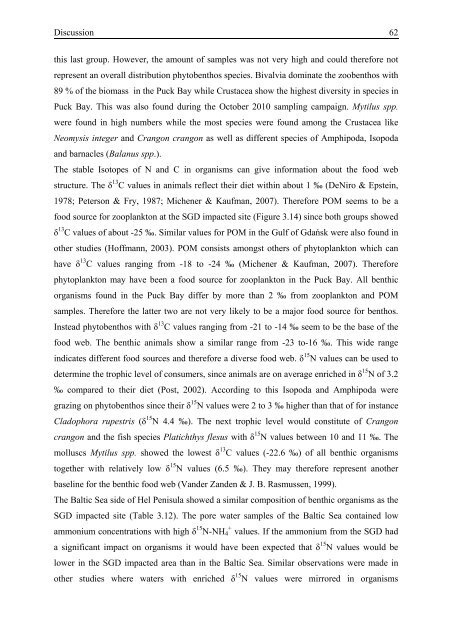Poland - IOW
Poland - IOW
Poland - IOW
Create successful ePaper yourself
Turn your PDF publications into a flip-book with our unique Google optimized e-Paper software.
Discussion 62<br />
this last group. However, the amount of samples was not very high and could therefore not<br />
represent an overall distribution phytobenthos species. Bivalvia dominate the zoobenthos with<br />
89 % of the biomass in the Puck Bay while Crustacea show the highest diversity in species in<br />
Puck Bay. This was also found during the October 2010 sampling campaign. Mytilus spp.<br />
were found in high numbers while the most species were found among the Crustacea like<br />
Neomysis integer and Crangon crangon as well as different species of Amphipoda, Isopoda<br />
and barnacles (Balanus spp.).<br />
The stable Isotopes of N and C in organisms can give information about the food web<br />
structure. The δ 13 C values in animals reflect their diet within about 1 ‰ (DeNiro & Epstein,<br />
1978; Peterson & Fry, 1987; Michener & Kaufman, 2007). Therefore POM seems to be a<br />
food source for zooplankton at the SGD impacted site (Figure 3.14) since both groups showed<br />
δ 13 C values of about -25 ‰. Similar values for POM in the Gulf of Gdańsk were also found in<br />
other studies (Hoffmann, 2003). POM consists amongst others of phytoplankton which can<br />
have δ 13 C values ranging from -18 to -24 ‰ (Michener & Kaufman, 2007). Therefore<br />
phytoplankton may have been a food source for zooplankton in the Puck Bay. All benthic<br />
organisms found in the Puck Bay differ by more than 2 ‰ from zooplankton and POM<br />
samples. Therefore the latter two are not very likely to be a major food source for benthos.<br />
Instead phytobenthos with δ 13 C values ranging from -21 to -14 ‰ seem to be the base of the<br />
food web. The benthic animals show a similar range from -23 to-16 ‰. This wide range<br />
indicates different food sources and therefore a diverse food web. δ 15 N values can be used to<br />
determine the trophic level of consumers, since animals are on average enriched in δ 15 N of 3.2<br />
‰ compared to their diet (Post, 2002). According to this Isopoda and Amphipoda were<br />
grazing on phytobenthos since their δ 15 N values were 2 to 3 ‰ higher than that of for instance<br />
Cladophora rupestris (δ 15 N 4.4 ‰). The next trophic level would constitute of Crangon<br />
crangon and the fish species Platichthys flesus with δ 15 N values between 10 and 11 ‰. The<br />
molluscs Mytilus spp. showed the lowest δ 13 C values (-22.6 ‰) of all benthic organisms<br />
together with relatively low δ 15 N values (6.5 ‰). They may therefore represent another<br />
baseline for the benthic food web (Vander Zanden & J. B. Rasmussen, 1999).<br />
The Baltic Sea side of Hel Penisula showed a similar composition of benthic organisms as the<br />
SGD impacted site (Table 3.12). The pore water samples of the Baltic Sea contained low<br />
ammonium concentrations with high δ 15 N-NH + 4 values. If the ammonium from the SGD had<br />
a significant impact on organisms it would have been expected that δ 15 N values would be<br />
lower in the SGD impacted area than in the Baltic Sea. Similar observations were made in<br />
other studies where waters with enriched δ 15 N values were mirrored in organisms
















